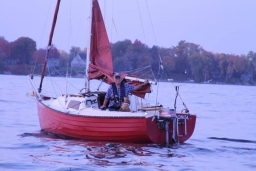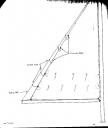An Alternative To Lazy Jacks (Edit 9/22/21) Total Page Hits: 2820
Post Type: Technical/Project
Boat Part: Mainsail
Date Modified: 09/26/2021 5:52 PM
Lazy jacks can be a big help in keeping the mainsail under control when it is lowered. They keep it from falling off the boom, spilling into the cockpit, and causing chaos. They are not without their drawbacks however. They often get in the way when raising the sail, and many configurations need to be adjusted once the sail is up and/or before it is lowered. I have tried a number of different configurations on my previous boat and was not completely satisfied with any of them. I have used permanent jacks as well as several variations of removeable/retractable jacks involving shock cord retainers and hooks. They all worked, after a fashion, but none seemed to be worth the trouble.
I got the idea for this "leech line furling system" from a North Sails ad in a 1980s sailing magazine. In the ad, their "Lazymate" system seemed to me to be overly complicated. It used special slides on the luff and a plethora of leech lines. Their system apparently did not sell very well as it was not marketed for long. But the basic idea seemed sound so I experimented with a simplified homemade version.
In its simplest form, a few lines attached to the leech of the sail slide up and down on the topping lift. At rest, the weight of the boom is supported by the topping lift. When the sail is raised, the boom is supported by the sail itself, causing the topping lift to go slack. The leech lines are also slack and out of the way. When the sail starts to come down, the boom's weight is transferred back to the topping lift, causing it to tighten. The triangular geometry of the sail also causes the loose leech lines to tighten as they slide down toward the boom. When properly set up they pull the leech of the sail aft at each attachment point, forcing the sail to neatly flake itself on top of the boom. How much of the sail stays on the boom is determined by the number and placement of the leech lines. On a small trailer sailor, only three or four can be enough to keep the sail completely out of the cockpit.
I tried a number of different ways to make the lines slide on the topping lift. Simple bowlines worked but often got tangled with each other. They also took time to tie when getting set up at the ramp. Stainless rings could work but the topping lift would have to be threaded through them at set up. Small brass snap hooks or aluminum carabiners are a fast and effective alternative but even these can snag each other if the sail flogs when coming down. I finally settled on small stainless locking carabiners I found on Amazon. These have worked flawlessly.
I used 1/8" Dyneema for the leech lines themselves because I had it on hand from other projects. It is very light, very strong, and doesn't stretch. I spliced loops on the ends and cow hitched them through the grommets and to the carabiners.
You can try out a limited version of this system without making any changes to your sail. Just use the two leech reefing grommets if you have them. Tie a short piece of line to each grommet and attach a snap hook, carabiner, or shackle to its other end. Snap each of these around the topping lift. The lines should be adjusted so that they pull the leech aft and keep that part of the sail on top of the boom. Then raise the sail and go sailing. When you are finished and drop the mainsail you will find that the lines keep lower part of the sail from falling into the cockpit.
Of course the upper (forward when on the boom) part of the sail will still be uncontained. Once you have tried it and convinced yourself that this system works you can go ahead and add a few more spur grommets evenly spaced along the leech. Because of the sail's triangular shape, the leech lines need to be progressively longer as you get closer to the head. I chose not to add grommets to the upper third of the sail. That part settles well forward of the cockpit and is out of the way. I found that a total of 4 leech lines, including the ones at the reef grommets, are sufficient for my M17.
The grommets and an installation tool can be purchased at Sailrite.com
I have used this mainsail containment system for the last 7 years on my Montgomery 17 and for over 30 years on my VN23. I am convinced that it works better than Lazy Jacks with far less hassle.
Edit 9/22/21
I saw a great idea on another boat at Blake Island during the Salish 100 in July. The boat was a Potter 19 owned by Tom Luque, the MastGates.com guy. He had a pair of permanent wire baby stays rigged for keeping the mast steady while raising and lowering. Rather than remove them completely when not needed he just disconnected their lower ends and brought them up to the boom to serve as single line lazy jacks. The plastic covered wires form a loose arc that contain the forward part of the sail. Tom's main has full battens so, with the forward part contained on the boom by the single line jacks, the after part just falls in line.
I thought this would be a great complement to my leech line furling system. The leech lines control the aft end while the baby stay lazy jacks contain the forward third.
My baby stays are Dyneema rather than wire and have trapeze clam cleats for adjustment at their lower ends. (They need to have some adjustability because of the slotted type tabernacle that lets the mast base drop down several inches as the mast goes up.) When attached to the boom the clam cleats hang just below it so they don't bang against the aluminum or chafe the sail. They are far enough forward over the cabin top that there is no danger of head banging. The weight of the clam cleats takes up the slack in the lines so they do not have the catenary of Tom's wire stays. They look as though they are very tight but in reality are very loose.
This modification is still a work in progress for me but so far it is working well. The leech lines keep the after part of the sail from spilling into the cockpit while the baby stay lazy jacks contain the forward part. I also see a small benefit in decreasing set up time at the ramp: the baby stays are permanently connected to the mast. Their lower ends just need to be clipped to the corresponding pad eyes on deck.




















